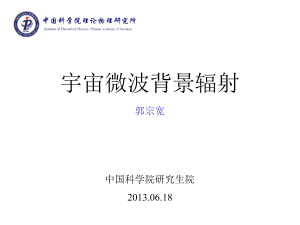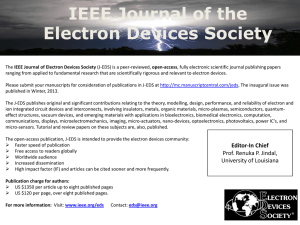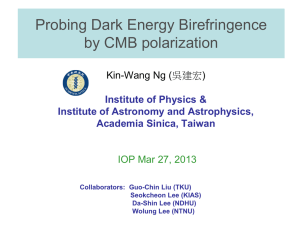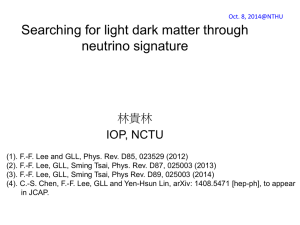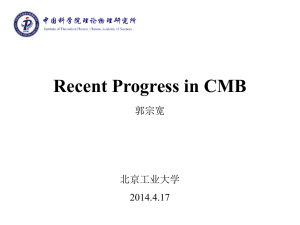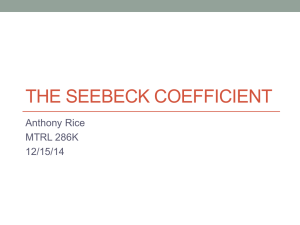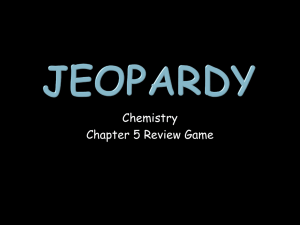PPTX - COSMO 2014
advertisement
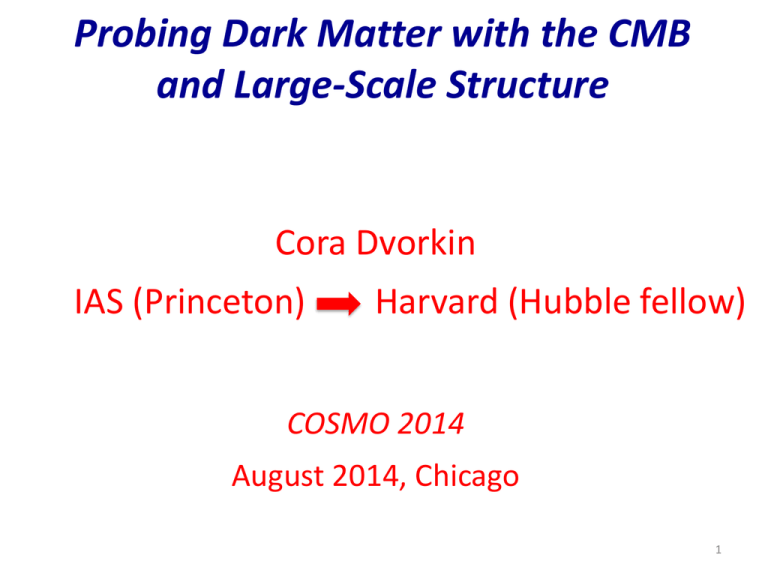
Probing Dark Matter with the CMB and Large-Scale Structure Cora Dvorkin IAS (Princeton) Harvard (Hubble fellow) COSMO 2014 August 2014, Chicago 1 Outline Dark Matter overview. Effect of WIMP Dark Matter Annihilation on the CMB: Homogeneous scenario. Inhomogeneous scenario: boosted electron perturbations (Non-Gaussian signal). • Other effects: enhanced matter temperature fluctuations; key observable: 21 cm radiation field; CMB B-mode polarization. Effect of Dark Matter-baryon interactions on the CMB and the Large-Scale Structure. 2 Evidence for Dark Matter Overwhelming evidence for Dark Matter: Galactic scales Cluster scales Cosmic Microwave Background Galaxy rotation curves The cosmic microwave background Gravitational lensing multipole moment l 3 Looking for Dark Matter off the beaten track Where do Dark Matter interactions matter? Some well known avenues: Excess high energy cosmic/gamma rays; Missing energy at colliders; Nucleon recoil deep underground; … Important to look for new processes 4 WIMP Dark Matter Annihilation FINAL PRODUCTS 5 Standard Recombination Peebles, ApJ (1968) Z’eldovich and Sunyaev, JETP (1969) Effective Boltzmann equation for the free electron density: 6 Standard Recombination Peebles, ApJ (1968) Z’eldovich and Sunyaev, JETP (1969) Effective Boltzmann equation for the free electron density: Recombination rate 7 Standard Recombination Peebles, ApJ (1968) Z’eldovich and Sunyaev, JETP (1969) Effective Boltzmann equation for the free electron density: Recombination rate Ionization rate 8 DM Annihilation in Recombination Effective Boltzmann equation for the free electron density: Recombination rate Ionization rate Energy injected into the plasma per unit volume, per unit time: (Majorana particle) Chen and Kamionkowski (2004)9 Padmanabhan and Finkbeiner (2005) 1/Mpc Time scales (Recombination, Ionization, Expansion) z (redshift) C. Dvorkin, K. Blum, and M. Zaldarriaga, Phys. Rev. D (2013) 10 xe (ionization fraction) Free electron fraction evolution z (redshift) 11 Effect on the CMB Temperature A higher ionization suppresses the CMB temperature fluctuations Degeneracy: Padmanabhan and Finkbeiner (2005) multipole moment l Current CMB constraints are GeV searches, that are most sensitive to Complementary to direct detection GeV, due to kinematical considerations. 12 Effect on the CMB Polarization A higher ionization enhances the polarization fluctuations at large scales multipole moment l • Screening of the observed spectrum at l>100. • Re-scattering of photon generates extra polarization at large scales. 13 Current and Future Dark Matter Annihilation Constraints from the CMB Thermal cross section M. Madhavacheril, N. Sehgal, T. Slatyer, Phys. Rev. D (2014) • Planck polarization data: coming this year. • CMB “Stage IV” experiment is being planned now! W. Wu, J. Errard, C. Dvorkin, C. L. Kuo, A. Lee, et al., ApJ (2014) 14 Dark Matter Annihilation Inhomogeneous scenario There are growing ionization modes that track the collapse of matter overdensities. k=0.04 Mpc-1 k=0.3 Mpc-1 perturbation perturbation k=0.04 Mpc-1 time [Mpc] time C. Dvorkin, K. Blum, and M. Zaldarriaga, Phys. Rev. D (2013) [Mpc] 15 Comparison to standard first order electron perturbations Order of magnitude boost! wave number k [1/Mpc] C. Dvorkin, K. Blum, and M. Zaldarriaga, Phys. Rev. D (2013) 16 Comparison to standard first order electron perturbations Order of magnitude boost! wave number k [1/Mpc] C. Dvorkin, K. Blum, and M. Zaldarriaga, Phys. Rev. D (2013) 17 Can we observe electron density perturbations in the CMB? CMB Bispectrum: probe of electron density perturbations. • Signal-to-noise 0.5 for Planck; polarization will have more information (work in progress). • The main boost in the electron perturbations by DM annihilation occurs on small scales, l>3000 (challenging to observe in temperature). C. Dvorkin, K. Blum, and M. Zaldarriaga, Phys. Rev. D (2013) 18 Matter temperature fluctuations Enhanced Matter Temperature fluctuations Current and future 21 cm experiments: LOFAR, MWA, PAPER, SKA, etc, etc.. wave number k [1/Mpc] There should be more information in the 21 cm radiation field (future work). 19 Beyond the WIMP paradigm • It has been pointed out that Dark Matter self-interactions and Dark Matter-Baryon interactions can significantly affect small-scale structure. Spergel and Steinhardt (2000); Wandelt et al. (2000) • Baryon processes such as star formation, supernova feedback, gas accretion, etc. can have important effects, but these processes are partially understood theoretically and poorly constrained observationally. 20 Dark Matter-Baryon Interactions Goal: to use observational probes of the CMB and matter fluctuations (where the theory is under better control) to know how much interaction between baryons and Dark Matter can occur today. C. Dvorkin, K. Blum and M. Kamionkowski, Phys. Rev. D (2013) 21 Dark Matter-Baryon Interactions C. Dvorkin, K. Blum and M. Kamionkowski, Phys. Rev. D (2013) Dark Matter-baryon momentum exchange rate: with for for 22 Effect on the Matter Power Spectrum wave number k [h/Mpc] C. Dvorkin, K. Blum and M. Kamionkowski, Phys. Rev. D (2013) 23 Effect on the Matter Power Spectrum Lyman-alpha wave number k [h/Mpc] C. Dvorkin, K. Blum and M. Kamionkowski, Phys. Rev. D (2013) 24 Constraining Dark Matter-Baryon Scattering with Cosmology All the curves ( ) are normalized to satisfy a mean free path of 1 Mpc in a system like the Milky Way, with , and . z (redshift) C. Dvorkin, K. Blum and M. Kamionkowski, Phys. Rev. D (2013) 25 Minimal mean free path for baryons scattering on Dark Matter in the Milky Way Mean free path: (CMB data: from Planck; Ly-alpha data: from the Sloan Digital Sky Survey) A baryon in the halo of a galaxy like our Milky Way does not scatter from Dark Matter particles during the age of the Universe. C. Dvorkin, K. Blum and M. Kamionkowski, Phys. Rev. D (2013) 26 Conclusions We will be able to put strong constraints on Dark Matter Annihilation with future CMB observations (currently complementary to direct detection constraints). WIMP Dark matter annihilation leads to growing ionization modes that track the collapse of dark matter overdensities (boosted by 1 to 2 orders of magnitude at small scales relative to standard model). Electron perturbations source CMB Non-Gaussianities at recombination. Enhanced matter temperature fluctuations at late times (natural observational tool: 21 cm radiation – future work). Using CMB data from Planck + Ly-alpha forest measurements from the Sloan Digital Sky Survey, we conclude that a baryon in the halo of a Galaxy like our Milky Way does not scatter from Dark Matter particles during the age 27 of the Universe. Can we observe electron density perturbations in the CMB? CMB Bispectrum: probe of electron density perturbations • From perturbed visibility: anisotropic optical depth. The first and second order anisotropies today are given by the line of sight solutions to the Boltzmann equation: Seljak and Zaldarriaga (1996) 28 Can we observe electron density perturbations in the CMB? CMB Bispectrum: probe of electron density perturbations • From perturbed visibility: anisotropic optical depth. New anisotropies generated by electron perturbations: 29 Can we observe electron density perturbations in the CMB? Signal-to-noise 0.5 for Planck; polarization will have more information (work in progress). at peak visibility at half-maximum visibility multipole moment l multipole moment l The main boost in the electron perturbations by DM annihilation occurs on small scales, l>3000 (challenging to observe). C. Dvorkin, K. Blum, and M. Zaldarriaga, Phys. Rev. D (2013) 30 Perturbed Harmonic Oscillator • Solve the perturbed Boltzmann equation up to second order in the tight coupling limit ( ) and identify the physical processes: Sound speed Silk damping • Solution given by WKB’s Green function. C. Dvorkin, K. Blum, and M. Zaldarriaga, in preparation 31 Imprints on the CMB Power Spectrum from Dark Matter-Baryon scattering multipole moment l C. Dvorkin, K. Blum and M. Kamionkowski, Phys. Rev. D (2013) 32
